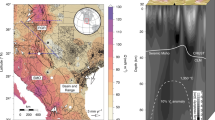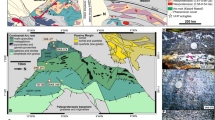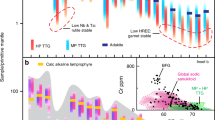Abstract
During the early Archaean, the Earth was too hot to sustain rigid lithospheric plates subject to Wilson Cycle-style plate tectonics. Yet by that time, up to 50% of the present-day continental crust was generated. Preserved continental fragments from the early Archaean have distinct granite-dome/greenstone-keel crust that is interpreted to be the result of a gravitationally unstable stratification of felsic proto-crust overlain by denser mafic volcanic rocks, subject to reorganization by Rayleigh–Taylor flow. Here we provide age constraints on the duration of gravitational overturn in the East Pilbara Terrane. Our U–Pb ages indicate the emplacement of ~3,600–3,460-million-year-old granitoid rocks, and their uplift during an overturn event ceasing about 3,413 million years ago. Exhumation and erosion of this felsic proto-crust accompanied crustal reorganization. Petrology and thermodynamic modelling suggest that the early felsic magmas were derived from the base of thick (~43 km) basaltic proto-crust. Combining our data with regional geochronological studies unveils characteristic growth cycles on the order of 100 million years. We propose that maturation of the early crust over three of these cycles was required before a stable, differentiated continent emerged with sufficient rigidity for plate-like behaviour.
This is a preview of subscription content, access via your institution
Access options
Access Nature and 54 other Nature Portfolio journals
Get Nature+, our best-value online-access subscription
$29.99 / 30 days
cancel any time
Subscribe to this journal
Receive 12 print issues and online access
$259.00 per year
only $21.58 per issue
Buy this article
- Purchase on Springer Link
- Instant access to full article PDF
Prices may be subject to local taxes which are calculated during checkout



Similar content being viewed by others
References
Van Thienen, P., Vlaar, N. J. & van den Berg, A. P. Plate tectonics on the terrestrial planets. Phys. Earth Planet. Inter. 142, 61–74 (2004).
Bédard, J. H. A catalytic delamination-driven model for coupled genesis of Archaean crust and sub-continental lithospheric mantle. Geochim. Cosmochim. Acta 70, 1188–1214 (2006).
Hoffmann, J. E., Nagel, T. J., Münker, C., Næraa, T. & Rosing, M. T. Constraining the process of Eoarchean TTG formation in the Itsaq Gneiss Complex, southern West Greenland. Earth Planet. Sci. Lett. 388, 374–386 (2014).
Moore, W. B. & Webb, A. A. G. Heat-pipe Earth. Nature 501, 501–505 (2013).
Sizova, E., Gerya, T., Stüwe, K. & Brown, M. Generation of felsic crust in the Archean: a geodynamic modelling perspective. Precamb. Res. 271, 198–224 (2015).
Hastie, A. R., Fitton, J. G., Bromiley, G. D., Butler, I. B. & Odling, N. W. A. The origin of Earth's first continents and the onset of plate tectonics. Geology 44, 855–858 (2016).
Rozel, A. B., Golabek, G. J., Jain, C., Tackley, P. J. & Gerya, T. Continental crust formation on early Earth controlled by intrusive magmatism. Nature 545, 332–335 (2017).
Bédard, J. H. Stagnant lids and mantle overturns: implications for Archaean tectonics, magmagenesis, crustal growth, mantle evolution, and the start of plate tectonics. Geosci. Front 9, 19–49 (2018).
Kamber, B. S. The evolving nature of terrestrial crust from the Hadean, through the Archaean, into the Proterozoic. Precamb. Res. 258, 48–82 (2015).
Van Kranendonk, M. J., Smithies, R. H., Hickman, A. H., Wingate, M. T. D. & Bodorkos, S. Evidence for Mesoarchean (~3.2 Ga) rifting of the Pilbara Craton: the missing link in an early Precambrian Wilson cycle. Precamb. Res 177, 145–161 (2010).
Dhuime, B., Hawkesworth, C. J., Cawood, P. A. & Storey, C. D. A change in the geodynamics of continental growth 3 billion years ago. Science 335, 1334–1336 (2012).
Debaille, V. et al. Stagnant-lid tectonics in early Earth revealed by 142Nd variations in late Archean rocks. Earth Planet. Sci. Lett. 373, 83–92 (2013).
Sharp, D. H. An overview of Rayleigh-Taylor instability. Phys. D 12, 3–18 (1984).
Collins, W. J., Van Kranendonk, M. J. & Teyssier, C. Partial convective overturn of Archaean crust in the Pilbara Craton, Western Australia: driving mechanisms and tectonic Implications. J. Struct. Geol. 20, 1405–1424 (1998).
Thébaud, N. & Rey, P. F. Archean gravity-driven tectonics on hot and flooded continents: controls on long-lived mineralized hydrothermal systems away from continental margins. Precamb. Res. 229, 93–104 (2013).
François, C., Philippot, P., Rey, P. & Rubatto, D. Burial and exhumation during Archean sagduction in the East Pilbara Granite-Greenstone Terrane. Earth Planet. Sci. Lett. 396, 235–251 (2014).
Van Kranendonk, M. J. et al. in Continent Formation Through Time Spec. Pub. Vol. 389 (eds Roberts, N. M. W. et al.) 83–111 (Geological Society, London, 2015).
Robin, C. M. I. & Bailey, R. C. Simultaneous generation of Archean crust and subcratonic roots by vertical tectonics. Geology 37, 523–526 (2009).
Smithies, R. H., Van Kranendonk, M. J. & Champion, D. C. It started with a plume—early Archaean basaltic proto-continental crust. Earth Planet. Sci. Lett. 238, 284–297 (2005).
Kamber, B. S., Whitehouse, M. J., Bolhar, R. & Moorbath, S. Volcanic resurfacing and the early terrestrial crust: zircon U-Pb and REE constraints from the Isua Greenstone Belt, southern West Greenland. Earth Planet. Sci. Lett. 240, 276–290 (2005).
Smithies, R. H., Champion, D. C. & Van Kranendonk, M. J. Formation of Paleoarchean continental crust through infracrustal melting of enriched basalt. Earth Planet. Sci. Lett. 281, 298–306 (2009).
Johnson, T. E., Brown, M., Gardiner, N. J., Kirkland, C. L. & Smithies, R. H. Earth’s first stable continents did not form by subduction. Nature 543, 239–242 (2017).
Kemp, A. I. S., Hickman, A. H., Kirkland, C. L. & Vervoort, J. D. Hf isotopes in detrital and inherited zircons of the Pilbara Craton provide no evidence for Hadean continents. Precamb. Res. 261, 112–126 (2015).
Taylor, J., Zeh, A. & Gerdes, A. U-Pb-Hf isotope systematics of detrital zircons in high-grade paragneisses of the Ancient Gneiss Complex, Swaziland: evidence for two periods of juvenile crust formation,Paleo- and Mesoarchean sediment deposition, and 3.23 Ga terrane accretion. Precamb. Res. 280, 205–220 (2016).
Buick, R. et al. Record of emergent continental crust ~3.5 billion years ago in the Pilbara craton of Australia. Nature 375, 574–577 (1995).
Wiemer, D., Schrank, C. E., Murphy, D. T. & Hickman, A. H. Lithostratigraphy and structure of the early Archaean Doolena Gap greenstone belt, East Pilbara Terrane, Western Australia. Precamb. Res. 282, 121–138 (2016).
Hickman, A. H. & Van Kranendonk, M. J. Early Earth evolution: evidence from the 3.5-1.8 Ga geological history of the Pilbara region of Western Australia. Episodes 35, 283–297 (2012).
Hickman, A. H. Regional Review of the 3426–3350 Ma Strelley Pool Formation, Pilbara Craton, Western Australia Record 2008/15 (Geological Survey of Western Australia, 2008).
Johnson, T. E., Brown, M., Kaus, B. J. P. & Van Tongeren, J. A. Delamination and recycling of Archaean crust caused by gravitational instabilities. Nat. Geosci. 7, 47–52 (2014).
Schmidt, M. W. & Poli, S. Magmatic epidote. Rev. Mineral. Geochem. 56, 399–430 (2004).
Palin, R. M., White, R. W. & Green, E. C. R. Partial melting of metabasic rocks and the generation of tonalitic-trondhjemitic-granodioritic (TTG) crust in the Archaean: constraints from phase equilibrium modelling. Precamb. Res. 287, 73–90 (2016).
Bodorkos, S. & Sandiford, M. in Archean Geodynamics and Environments Mono. Ser. Vol. 164 (eds Benn, K. et al.) 1–17 (American Geophysical Union, 2006).
Korenaga, J. Initiation and Evolution of Plate Tectonics on Earth: theories and Observations. Annu. Rev. Earth Planet. Sci. 41, 117–151 (2013).
Smithies, R. H., Champion, D. C. & Cassidy, K. F. Formation of Earth’s early Archaean continental crust. Precamb. Res. 127, 89–101 (2003).
Lana, C., Tohver, E. & Cawood, P. Quantifying rates of dome-and-keel formation in the Barberton granitoid-greenstone belt, South Africa. Precamb. Res. 177, 199–211 (2010).
Zegers, T. E., de Wit, M. J., Dann, J. & White, S. H. Vaalbara, Earth’s oldest assembled supercontinent? A combined structural, geochronological, and palaeomagnetic test. Terra Nova 10, 250–259 (1998).
Drabon, N., Lowe, D. R., Byerly, G. R. & Harrington, J. A. Detrital zircon geochronology of sandstones of the 3.6-3.2 Ga Barberton greenstone belt: no evidence for older continental crust. Geology 45, 803–806 (2017).
Srinivasa Sarma, D., McNaughton, N. J., Belousova, E., Ram Mohan, M. & Fletcher, I. R. Detrital zircon U-Pb ages and Hf-isotope systematics from the Gadag Greenstone Belt: Archean crustal growth in the western Dharwar Craton, India. Gondwana Res. 22, 843–854 (2012).
Guitreau, M., Mukasa, S. B., Loudin, L. & Krishnan, S. New constraints on the early formation of the Western Dharwar Craton (India) from igneous zircon U-Pb and Lu-Hf isotopes. Precamb. Res. 302, 33–49 (2017).
Lancaster, P. J., Dey, S., Storey, C. D., Mitra, A. & Bhunia, R. K. Contrasting crustal evolution processes in the Dharwar craton: Insights from detrital zircon U-Pb and Hf isotopes. Gondwana Res. 28, 1361–1372 (2015).
Horstwood, M. S. A., Nesbitt, R. W., Noble, S. R. & Wilson, J. F. U-Pb zircon evidence for an extensive early Archean craton in Zimbabwe: a reassessment of the timing of craton formation, stabilization, and growth. Geology 27, 707–710 (1999).
Bolhar, R. et al. Juvenile crust formation in the Zimbabwe Craton deduced from O-Hf isotopic record of 3.8-3.1 Ga detrital zircons. Geochim. Cosmochim. Acta 215, 432–446 (2017).
Nagel, T. J., Hoffmann, J. E. & Münker, C. Generation of Eoarchean tonalite-trondhjemite-granodiorite series from thickened mafic crust. Geology 40, 375–378 (2012).
Hawkesworth, C. J., Cawood, P. A. & Dhuime, B. Tectonics and crustal evolution. GSA Today 26, 4–11 (2016).
Wilson, J. T. Static or mobile Earth: the current scientific revolution. Proc. Am. Phil. Soc. 112, 309–320 (1968).
Wiemer, D., Allen, C. M., Murphy, D. T. & Kinaev, I. Effects of thermal annealing and chemical abrasion on ca. 3.5 Ga metamict zircon and evidence for natural reverse discordance: insights for U-Pb LA-ICP-MS dating. Chem. Geol. 466, 285–302 (2017).
Black, L. P. et al. Improved 206Pb/238U microprobe geochronology by the monitoring of a trace-element-related matrix effect; SHRIMP, ID-TIMS, ELA-ICP-MS and oxygen isotope documentation for a series of zircon standards. Chem. Geol. 205, 115–140 (2004).
Sláma, J. et al. Plešovice zircon - a new natural reference material for U-Pb and Hf isotopic microanalysis. Chem. Geol. 249, 1–35 (2008).
Jochum, K. P. et al. Determination of reference values for NIST SRM 610-617 glasses following ISO guidelines. Geostand. Geoanal. Res 35, 397–429 (2011).
Paton, C. et al. Improved laser ablation U-Pb zircon geochronology through robust downhole fractionation correction . Geochem. Geophys. 11, Q0AA06 (2010).
Watson, E. B., Wark, D. A. & Thomas, J. B. Crystallization thermometers for zircon and rutile. Contrib. Mineral. Petrol. 151, 413–433 (2006).
Markwitz, V. et al. Variations in zircon provenance constrain age and geometry of an early Paleozoic rift in the Pinjarra Orogen, East Gondwana. Tectonics 36, 2477–2496 (2017).
Pidgeon, R. T. Zircon radiation damage ages. Chem. Geol. 367, 13–22 (2014).
Weber, U. D., Kohn, B. P. & Gleadow, A. J. W. Muccan Batholith, Eastern Pilbara, Western Australia (Cooperative Research Centre for Landscape Environments and Mineral Exploration, 2004).
Kennedy, A. K., Kamo, S. L., Nasdala, L. & Timms, N. E. Grenville skarn titanite: potential reference material for SIMS U-Th-Pb analysis. Canad. Mineral. 48, 1423–1443 (2010).
Allen, C. M., Williams, I. S., Stephens, C. J. & Fielding, C. R. Granite genesis and basin formation in an extensional setting: the magmatic history of the Northernmost New England Orogen. Aust. J. Earth Sci. 45, 875–888 (1998).
Chew, D. M., Petrus, J. A. & Kamber, B. S. U-Pb LA-ICPMS dating using accessory mineral standards with variable common Pb. Chem. Geol. 363, 185–199 (2014).
Smithies, R. H., Champion, D. C., Van Kranendonk, M. J. & Hickman, A. H. Geochemistry of Volcanic Rocks of the Northern Pilbara Craton, Western Australia Report no. 104 (Western Australia Geological Survey, 2007).
Connolly, J. A. D. The geodynamic equation of state: what and how. Geochem. Geophys. 10, Q10014 (2009).
Holland, T. J. B. & Powell, R. An improved and extended internally consistent dataset for phases of petrological interest, involving a new equation of state for solids. J. Metamorph. Geol. 29, 333–383 (2011).
Green, E. C. R. et al. Activity-composition relations for the calculation of partial melting equilibria in metabasic rocks. J. Metamorph. Geol. 34, 845–869 (2016).
White, R. W., Powell, R., Holland, T. J. B., Johnson, T. E. & Green, E. C. R. New mineral activity-composition relations for thermodynamic calculations in metapelitic systems. J. Metamorph. Geol. 32, 511–527 (2014).
Holland, T. J. B. & Powell, R. Activity-composition relations for phases in petrological calculations: an asymmetric multicomponent formulation. Contrib. Mineral. Petrol. 145, 492–501 (2003).
White, R. W., Powell, R., Holland, T. J. B. & Worley, B. A. The effect of TiO2 and Fe2O3 on metapelitic assemblages at greenschist and amphibolite facies conditions: mineral equilibria calculations in the system K2O–FeO–MgO–Al2O3–SiO2–H2O–TiO2–Fe2O3. J. Metamorph. Geol. 18, 497–511 (2000).
White, R. W., Powell, R. & Clarke, G. L. The interpretation of reaction textures in Fe-rich metapelitic granulites of the Musgrave Block, central Australia: constraints from mineral equilibria calculations in the system K2O–FeO–MgO–Al2O3–SiO2–H2O–TiO2–Fe2O3. J. Metamorph. Geol. 20, 41–55 (2002).
Berry, A. J., Danyushevsky, L. V., O’Neill, H., Newville, M. & Sutton, S. R. Oxidation state of iron in komatiitic melt inclusions indicates hot Archaean mantle. Nature 455, 960–963 (2008).
Polat, A. Growth of Archean continental crust in oceanic island arcs. Geology 40, 383–384 (2012).
Martin, H., Moyen, J.-F., Guitreau, M., Blichert-Toft, J. & Le Pennec, J.-L. Why Archaean TTG cannot be generated by MORB melting in subduction zones. Lithos 198-199, 1–13 (2014).
Condie, K. C. Archean geotherms and supracrustal assemblages. Tectonophysics 105, 29–41 (1984).
Moyen, J.-F. & Martin, H. Forty years of TTG research. Lithos 148, 312–336 (2012).
Green, E. C. R., Holland, T. J. B. & Powell, R. An order-disorder model for omphacitic pyroxenes in the system jadeite-diopside-hedenbergite-acmite, with applications to eclogite rocks. Am. Mineral. 92, 1181–1189 (2007).
Diener, J. F. A. & Powell, R. Revised activity-composition models for clinopyroxene and amphibole. J. Metamorph. Geol. 30, 131–142 (2011).
Pattinson, D. R. M. Petrogenetic significance of orthopyroxene-free garnet + clinopyroxene + plagioclase ± quartz-bearing metabasites with respect to the amphibolite and granulite facies. J. Metamorph. Geol. 21, 21–34 (2003).
Shaw, D. M. Trace element fractionation during anatexis. Geochim. Cosmochim. Acta 34, 237–243 (1970).
Martin, H. Petrogenesis of Archaean trondhjemites, tonalites, and granodiorites from Eastern Finland: major and trace element geochemistry. J. Petrol. 28, 921–953 (1987).
Neuman, H., Mead, J. & Vitaliano, C. J. Trace element variation during fractional crystallization as calculated from the distribution law. Geochim. Cosmochim. Acta 6, 90–99 (1954).
Leeman, W. P. & Phelps, D. W. Partitioning of rare Earths and other trace elements between sanidine and coexisting volcanic glass. J. Geophys. Res. 86, 10193–10199 (1981).
Acknowledgements
The Geological Survey of Western Australia supported fieldwork logistics. Analytics were carried out at the Central Analytical Research Facility (CARF), Institute for Future Environments, Queensland University of Technology (QUT). Staff of the CARF assisted sample preparation. K.H. Moromizato assisted LA-ICP-MS analyses. The findings of this study are based on a PhD thesis by D.W. (QUT). Titanite geochronological data are from an MSc thesis by L.W. (QUT).
Author information
Authors and Affiliations
Contributions
D.W., C.E.S. and D.T.M conducted field work and came up with the idea of the paper. D.T.M conceived the project. D.W. wrote the manuscript draft of the paper and drafted the figures. All authors contributed to discussions and writing of the final paper. D.W., C.M.A. and L.W. generated and evaluated geochronological data. D.W. and D.T.M. evaluated geochemical data. D.W. performed thermodynamic calculations.
Corresponding author
Ethics declarations
Competing interests
The authors declare no competing interests.
Additional information
Publisher’s note: Springer Nature remains neutral with regard to jurisdictional claims in published maps and institutional affiliations.
Supplementary information
Supplementary Information
Supplementary Figures
Supplementary Table 1
Zircon U–Pb data
Supplementary Table 2
Titanite U–Pb data
Supplementary Table 3
Rock geochemical data
Rights and permissions
About this article
Cite this article
Wiemer, D., Schrank, C.E., Murphy, D.T. et al. Earth's oldest stable crust in the Pilbara Craton formed by cyclic gravitational overturns. Nature Geosci 11, 357–361 (2018). https://doi.org/10.1038/s41561-018-0105-9
Received:
Accepted:
Published:
Issue Date:
DOI: https://doi.org/10.1038/s41561-018-0105-9
This article is cited by
-
3.7 billion year old detrital sediments in Greenland are consistent with active plate tectonics in the Eoarchean
Communications Earth & Environment (2024)
-
Deep formation of Earth’s earliest continental crust consistent with subduction
Nature Geoscience (2023)
-
Geodynamic oxidation of Archean terrestrial surfaces
Communications Earth & Environment (2023)
-
Evidence of secular variation in Archean crust formation in the Eastern Indian Shield
Scientific Reports (2022)
-
Oxygen isotopes trace the origins of Earth’s earliest continental crust
Nature (2021)



